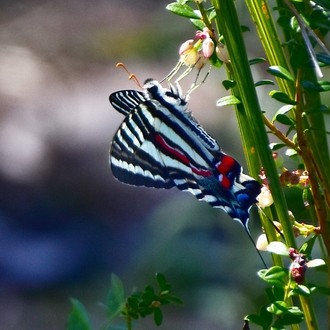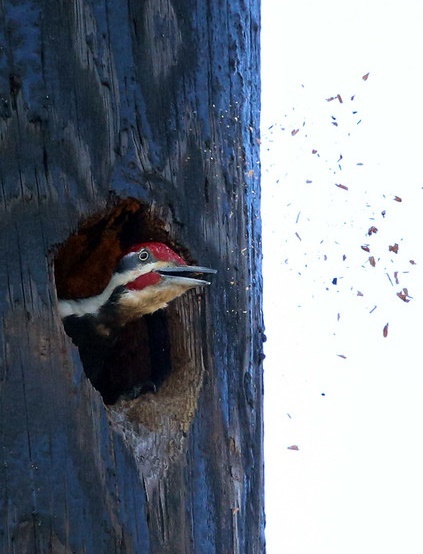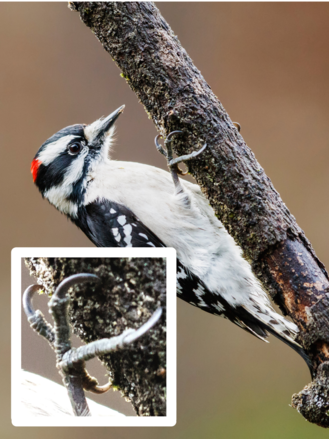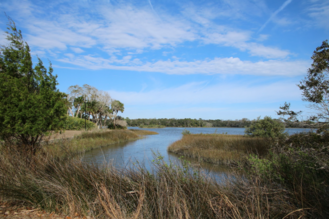 WildQuest participants submitted lots of gorgeous photos like this one of a zebra swallowtail to complete the scavenger hunt missions.
We would like to thank everyone who participated in last month’s WildQuest scavenger hunt on our wildlife management area (WMA) system! We had over 800 participating teams and individuals who together completed a whopping 4,651 missions.
We also want to offer a big congratulations to everyone who won in our random prize drawing, and we hope your field guides and binoculars will help you in your future WMA explorations
Here are some of the things our participants had to say when asked about their favorite parts of WildQuest:
"Loved getting out away from the sounds of the city and enjoying the sounds of nature. The birds chirping, the crickets and the frogs.. everything!”
“Favorite thing: it's so close to home! I had no idea.”
"Today we probably walked about 5 miles and we enjoyed all the family time looking for the items on the list."
“We loved the driving tour at Chassahowitzka WMA; your car will get dusty but it's so worth it!”
"I absolutely loved it! I learned so much! My favorite things were learning that Florida has a state wildflower, finding the air plants that grow on the trees with the moss, researching to figure out what type of wetland was lake Jackson - and I finally can identify poison ivy!"
If you missed this round of WildQuest, or if you want to join the adventure again, stay tuned – this won’t be our last statewide scavenger hunt. Future games will be announced right here in Kite Tales.
 Woodpeckers are powerful excavators, as demonstrated by this Pileated Woodpecker tossing woodchips out as it builds a nest cavity. (Photo by Tom Murray)
The reverberating echo of a woodpecker drilling into the bark of a tree or the soft wood of a snag is a familiar one to birders. The sound is so commonplace that we don’t usually stop to think about it beyond trying to get an ID – but have you ever wondered about how they manage to slam their bills so forcefully and so quickly without hurting themselves?
Woodpeckers are a fascinating group of birds with a host of adaptations that allow them to live their highly specialized lifestyle. They may peck anywhere between 8,000 and 12,000 times a day with their heads moving at up to 15 mph on each stroke, so it makes sense that they’d need some serious shock absorbers to prevent brain damage!
 The hyoid, which supports the woodpecker's toungue, wraps around the entire skull. This provides extra shock absorption, as well as allowing the bird to extend its tongue deep under bark and into holes in search of insects.
The bone in the skull is uniquely spongy, especially in the front and back. While this might sound counterintuitive, it means that the bone absorbs some shock as the head moves rapidly back and forth. They also have a unique hyoid bone. In most vertebrates, this bone sits in the neck and serves as the attachment for the tongue and the voicebox. In woodpeckers, this bone actually wraps around the entire skull, acting as an additional shock absorber. The length of the hyoid has another function, as well – it means that the attached tongue is much longer than in other species, also wrapping around the skull. This lets the birds probe deep under bark for insects.
 This Downy Woodpecker has zygodactyl feet, with two toes pointing forward and two backward. This gives it an extra strong grip. It also uses its stiff tail feathers for extra support and leverage.
Like any industrious carpenters, woodpeckers also need some special tools to efficiently drill into trees. Their bills are sharp and pointed like chisels, and their tail feathers, or retrices, are extra thick and reinforced so they can use them for leverage. They also have special feet referred to as zygodactyl. Instead of having three toes forward and one back, theirs are split two and two, giving them an extra strong grip. Woodpeckers even have the problem of flying sawdust covered with extra bristly feathers around their bills that act like a woodworker’s protective mask!
Next time you see a woodpecker in your backyard or on a wildlife viewing trip, hopefully you will get some time to observe and appreciate all the adaptions that make these birds so efficient at what they do. They are more than just biologically interesting, too – the cavities they create in trees can provide homes to cavity nesters who are unable to excavate themselves, and their feeding behavior is important for pest control. There is a lot to appreciate in these fascinating birds.

Address: 2500 Princess Place Road, Palm Coast, 32137
Open: Daily, 7 a.m. - 6 p.m.
Contact: 386-313-4020, FlaglerCounty.org
Once home to a Russian prince and his wife, this land is now a preserve with both freshwater and salt marsh, pine flatwoods and hardwood hammocks. On the property are historic buildings, an artesian spring, and several hiking, equestrian and driving trails. Watch for Wild Turkey and Northern Bobwhite along the road. Along Pellicer Creek, look for wading birds and alligators, foraging shorebirds (Greater and Lesser Yellowlegs, and Wilson’s Snipe) and ducks. The orange trail travels through sandhills and has two observation decks, one overlooking a freshwater marsh and one along Pellicer Creek — watch for raptors and woodpeckers. Flycatchers also frequent these edge areas. The yellow trail passes through salt marsh and a freshwater swamp. The accessible blue trail loops through a hardwood forest and out to an observation area on the edge of a salt marsh. By following the green trail through a swamp, you’ll find good migratory songbird habitat. The trail ends by circling an artesian spring-fed pond, around which Great Egrets and Great Blue Herons nest in season. Please do not disturb the nesting and roosting birds and respect the private property within this preserve. Kayaks can be rented on-site to explore Styles Creek, Pellicer Creek and Matanzas River. Cottages as well as equestrian and primitive camping are also available.
|